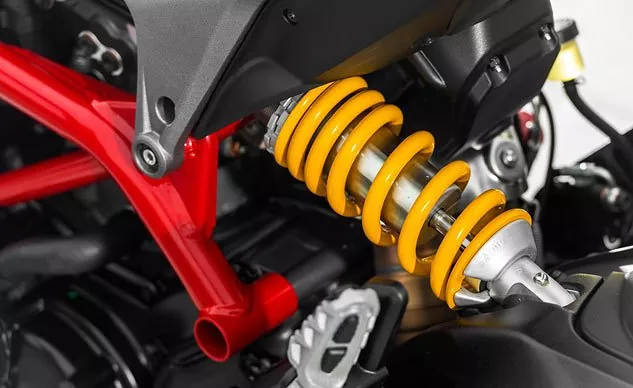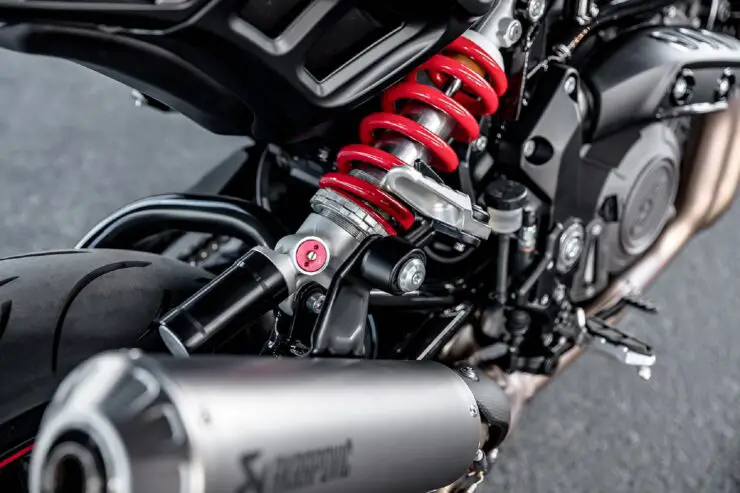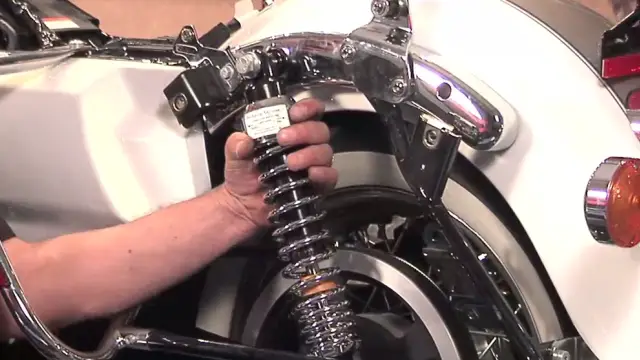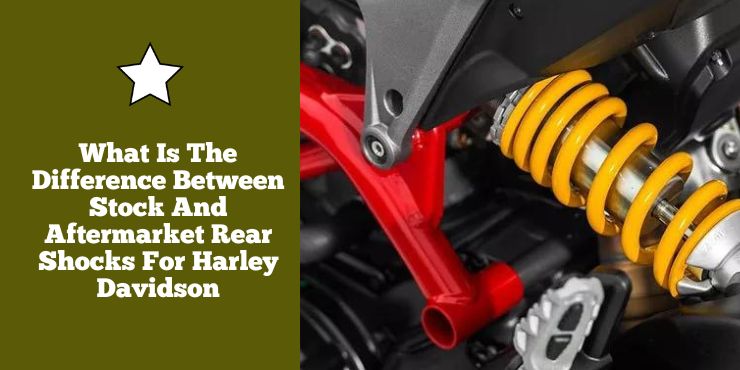If you’re a Harley-Davidson rider, you know the importance of high-quality shocks that provide you with a smooth ride. But what is the difference between stock and aftermarket rear shocks?
The main difference between stock and aftermarket rear shocks is performance; aftermarket shocks often offer adjustable settings, improved dampening, and materials for a smoother and more customized ride.
This article will explain the differences between the two and why you should consider upgrading to aftermarket shocks. With a better understanding of the different types of shocks available, you can make an informed decision on which shock is best suited for your Harley-Davidson motorcycle. So let’s dive into the details and see what’s the difference between stock and aftermarket rear shocks for Harley-Davidson!
What is the difference between stock and aftermarket rear shocks for Harley-Davidson?
When it comes to motorcycles, the suspension system plays a key role in ensuring a smooth, comfortable, and enjoyable ride. Harley-Davidson motorcycles, renowned for their ironic design and powerful performance, rely on rear shocks to absorb shocks, provide stability, and enhance the overall riding experience. There are two different types of rear shocks commonly used in Harley-Davidson bikes – stock rear shocks and aftermarket rear shocks. To know more about these rear shocks, you’ll want to know what is the difference between stock and aftermarket rear shocks for Harley-Davidson bikes.
>>> Click here to read our review of the Best Rear Shocks For Harley-Davidson <<<
Definition of stock rear shocks
Stock rear shocks or also known as OEM rear shocks are the standard shock absorbers that come pre-installed on a motorcycle when it is purchased from the manufacturer. These rear shocks are specifically designed and produced by the motorcycle brand to meet the general needs of riders and cater to a wide range of riding conditions.
Stock rear shocks offer a sense of familiarity as they come as original equipment from the factory. This makes them easily recognizable to rides and requires no additional research or decision-making during purchase.
These rear shocks are tuned to provide a balanced and comfortable ride for various terrains and everyday riding scenarios. They are intended to cater to the average rider’s preferences and the bike’s intended use. Since stock rear shocks are OEM parts, they are typically covered under the manufacturer’s warranty. This provides riders with peace of mind in case of any defects or issues.
Definition of aftermarket rear shocks
Aftermarket rear shocks are suspension components not manufactured by the original motorcycle brand but produced by third-party manufacturers specializing in motorcycle parts. These rear shocks are designed to offer performance enhancements, increased adjustability, and a customized riding experience beyond what stock shocks might provide.
Aftermarket rear shocks offer a higher level of customization. They come in a wide variety of designs and configurations, catering to specific riding styles and preferences. Many aftermarket shocks incorporate advanced damping technology and premium materials, providing improved performance over stock shocks.
Aftermarket rear shocks often come with adjustable features, such as damping settings and preload adjustments. This allows riders to fine-tune the suspension to match their individual riding style and the terrain they frequently encounter.
Some aftermarket rear shocks are also designed for specific riding applications, such as aggressive cornering or off-road adventures. This makes them suitable for riders seeking specialized performance in certain riding scenarios.

What is the difference between stocks and aftermarket rear shocks for Harley-Davidson?
Here are some of the common differences between stock rear shocks and aftermarket rear shocks for Harley-Davidson bikes –
#1. Customization
Aftermarket rear shocks offer a higher level of customization compared to stock shocks. Riders can tailor the suspension setup to match their individual preferences and specific riding style.
#2. Performance
Aftermarket rear shocks often provide improved performance over stock rear shocks due to advanced damping technology and premium materials.
#3. Adjustability
Aftermarket shocks typically offer adjustable features, allowing riders to fine-tune the suspension settings while stock rear shocks might have limited adjustability.
#4. Price
Aftermarket rear shocks tend to have a higher price tag compared to stock shocks. This happens largely due to their advanced features and technology.
#5. Warranty
Stock rear shocks are typically covered under the manufacturer’s warranty. Meanwhile, aftermarket rear shocks might have varying warranty coverage depending on the manufacturer.
Pros and cons of stock rear shocks for Harley-Davidson bikes
When it comes to Harley-Davidson bikes, the suspension systems help in ensuring a smooth and comfortable ride. As riders hit the open road, they rely on the rear shocks to absorb shocks and vibrations, providing stability and a comfortable ride. As riders hit the open road, they rely on the rear shocks to absorb shocks and vibrations, providing stability and enhancing the overall riding experience. Harley-Davidson bikes come equipped with stock rear shocks, which are the standard shock absorbers that come pre-installed from the factory.
Here are some of the primary advantages of stock rear shocks –
#1. Familiarity and factory fit
One of the primary advantages of stock rear shocks is their familiarity. As original equipment from the manufacturer, stock shocks come pre-installed on the bike, ensuring seamless and factory-fit integration. Harley-Davidson riders don’t need to research or make additional decisions during purchase as these shocks are standard on the bike.
#2. Reliability and warranty coverage
Harley-Davidson designs its stock rear shocks to meet the general needs of riders, providing a reliable and predictable suspension setup. Additionally, stock rear shocks are typically covered under the manufacturer’s warranty, offering peace of mind for riders in case of any defects or issues.
#3. Suitable for average riding conditions
Stock rear shocks are turned to suit average riding conditions and the intended use of the bike. They offer a balanced and comfortable ride for various terrains and everyday riding scenarios, making them suitable for most riders.
#4. Cost-effective
Since stock rear shocks come as standard equipment, they are typically included in the overall price of the bike. This makes them a cost-effective option for riders who might not have specific performance or customization preferences.
Here are some of the primary disadvantages of stock rear shocks –
#1. Limited customization
One of the primary disadvantages of stock rear shocks is their limited customization options. They might not cater to specific preferences or specialized riding styles, leaving riders seeking advanced performances or personalized comfort wanting more.
#2. Performance constraints
Depending on the bike model and intended use, stock rear shocks might have performance limitations for more aggressive riding styles or challenging terrains. Riders with advanced skill levels or specific riding demands might find stock shocks less suited to their needs.
#3. Adjustability
Stock rear shocks often lack adjustable features such as damping settings or height adjustments. This can limit the ability to fine-tune the suspension to match individual riding preferences and varying road conditions.
#4. Upgrade potential
While stock rear shocks offer a reliable and comfortable ride, some riders may outdraw their capabilities over time. As riders gain experience and seek to push the boundaries of their riding, they might find that aftermarket rear shocks offer superior performance and customization options.
Pros and cons of aftermarket rear shocks for Harley-Davidson bikes
Harley-Davidson motorcycles have long captured the hearts of motorcycle enthusiasts worldwide. As riders seek to elevate their riding experience, upgrading rear shocks with aftermarket options has become a popular choice. Aftermarket rear shocks are suspension components not manufactured by the original motorcycle brand but produced by third-party manufacturers specializing in motorcycle parts. You’ll need to have basic understanding of the advantages and disadvantages of aftermarket rear shocks for Harley-Davidson bikes, helping riders make informed decisions about their suspension upgrade.
Here are the biggest advantages of aftermarket rear shocks for Harley-Davidson bikes –
#1. Personalization and customization
One of the primary benefits of aftermarket rear shocks is the level of customization they offer. Harley-Davidson riders can choose from a wide range of options based on their specific needs, riding style, and terrain preferences. Whether it is enhanced performance, increased adjustability, or personalized comfort, aftermarket rear shocks cater to individual preferences.
#2. Performance upgrades
Many aftermarket rear shocks are engineered with advanced damping technology and premium materials, offering improved performance over stock shocks. These upgrades can result in enhanced cornering capabilities, reduced vibration, and improved stability, providing Harley-Davidson riders with a superior and more enjoyable riding experience.
#3. Adjustable features
Aftermarket rear shocks often come with adjustable features, such as damping settings and preload adjustments. This flexibility allows riders to fine-tune the suspension to match their riding style and road conditions, providing a personalized and optimized ride.
#4. Specialized applications
Some aftermarket rear shocks are designed for specific riding applications, such as off-road adventures or aggressive cornering. Riders looking for specialized performance in certain riding scenarios can find aftermarket options tailored to their needs.
Here are some of the primary disadvantages of aftermarket rear shocks in Harley-Davidson bikes –
#1. Higher cost
One of the primary drawbacks of aftermarket rear shocks is their higher cost compared to stock shocks. High-quality aftermarket options with advanced features and materials might come with a premium price tag. However, riders must weigh this cost against the performance benefits they offer.
#2. Compatibility issues
Not all aftermarket rear shocks are compatible with every Harley-Davidson bike model and year. Riders must make sure that they choose rear shocks specifically designed for their bike to avoid fitting issues and compromised performance.
#3. Warranty considerations
Depending on the manufacturer, aftermarket rear shocks might have varying warranty coverage. Riders must carefully review warranty policies to understand what is included and what might void the warranty.
#4. Installation expertise
Proper installation is important for ensuring optimal performance and safety with aftermarket rear shocks. While some Harley-Davidson riders might have the expertise to handle the installation themselves, others might require professional help from certified technicians.

Everything you need to know about coilover rear shocks for Harley-Davidson
As Harley-Davidson riders look to optimize their riding experience, the choice of rear shock becomes a critical consideration. Coilover rear shocks are a popular aftermarket option that offers a unique suspension setup with distinct advantages and disadvantages.
Coilover rear shocks are a specialized type of suspension component that combines the traditional shock absorber with a coil spring. The coil spring surrounds the shock absorber, creating a compact and integrated unit. The coil spring is responsible for supporting the weight of the bike while the shock absorber dampens vibrations and impact, offering a balanced and smooth ride.
Here are some of the advantages of coilover rear shocks –
#1. A high level of adjustability
One of the most significant advantages of coilover rear shocks is the high level of adjustability they provide. Harley-Davidson riders will be able to fine-tune the suspension settings, such as preload, compression, and rebound to match their riding style and specific preferences. This level of customization allows for a much more personalized and optimized ride.
#2. Enhanced performance
Coilover rear shocks often feature advanced damping technology and premium materials, resulting in improved performance over stock shocks. The combination of a coil spring and shock absorber offers superior support and stability, especially during cornering and aggressive riding.
#3. Height adjustability
Some coilover rear shocks offer height adjustability, offering riders the option to alter the bike’s ride height. This feature can be especially useful for riders who desire a lower or higher seat position or for optimizing the bike’s stance for various riding conditions.
#4. Increased load capacity
Coilover rear shocks are known for their ability to handle higher loads compared to stock shocks. This increased load capacity is highly beneficial for riders who regularly carry heavy loads or ride with a passenger.
Here are some of the disadvantages of coilover rear shocks –
#1. Cost of installation
Coilover rear shocks often come with a higher price tag compared to traditional aftermarket shocks. The advanced features and technology incorporated into coilovers contribute to the increased cost.
#2. Complex installation and tuning
Proper installation and tuning of coilover rear shocks might require expertise and professional assistance. Riders might need specialized tools and knowledge to adjust the settings accurately, potentially leading to added installation costs.
#3. Issues with compatibility
Not all coilover rear shocks are universally compatible with every Harley-Davidson bike model and year. Harley-Davidson riders must ensure that the chosen coilovers are specifically designed for their bike to ensure a proper fit and optimal performance.
#4. Stiffness
The coil spring in coilover rear shocks might result in a stiffer ride compared to traditional shocks. While this might suit some riders’ preferences, others might find it less comfortable, especially during extended rides on rough roads.
Everything you need to know about air shocks for Harley-Davidson
As technology has advanced, motorcycle enthusiasts are presented with a plethora of innovative suspension options to elevate their riding experience. Among these options, air shocks have gained popularity, offering a unique and customizable ride for Harley-Davidson bikes.
Air shocks or also known as air ride suspension or air-assisted suspension are a specialized type of suspension component that uses compressed air to adjust the bike’s ride height and damping characteristics. These shocks typically feature an air chamber, which can be pressurized or depressurized using an air pump or a compressor. By adjusting the air pressure, riders will be able to alter the firmness of the suspension and the bike’s height, offering a more customized and versatile riding experience.
Here are some of the advantages of air shocks in Harley-Davidson bikes –
#1. Customizable height
One of the primary advantages of air shocks is the ability to adjust the bike’s ride height. By increasing or decreasing the air pressure, riders will be able to raise or lower the bike to suit their preferences and specific riding conditions. This feature allows for improved ground clearance on rough terrain or a lower stance for a more aggressive appearance.
#2. Adjustable suspension stiffness
Air shocks provide riders with the flexibility to fine-tune the suspension stiffness to match their riding style and road conditions. Increased air pressure will result in a firmer suspension, ideal for sporty cornering and aggressive riding, while lower air pressure offers a softer ride for added comfort on long-distance journeys.
#3. Handle varying load capacities
Air shocks can effectively handle varying loads, making them suitable for riders who often carry passengers or additional luggage. The ability to adjust the air pressure allows the suspension to compensate for the added weight, ensuring a balanced and stable ride.
#4. Improved levels of comfort
By adjusting the suspension’s firmness, air shocks can provide a more comfortable ride by absorbing road imperfections and reducing vibrations. This feature is particularly beneficial for riders who seek a smoother and more enjoyable journey on different types of roads.
Here are some of the disadvantages of air shocks in Harley-Davidson bikes –
#1. Complexity and maintenance
The air suspension system adds complexity to the bike’s setup, requiring proper maintenance and periodic air pressure checks. Riders have to make sure that the air pressure remains within the recommended range to maintain optimal performance.
#2. A higher price tag
Air shocks tend to have a higher price tag compared to traditional rear shocks, primarily due to the additional technology and components required for air adjustment. This cost might be a limiting factor for budget-conscious riders.
#3. Risk of air leaks
Since air shocks tend to rely on compressed air, there is a risk of air leaks, which can result in decreased performance or a complete suspension failure. Regular checks for leaks are essential to avoid potential issues on the road.
#4. Expertise and installation
Proper installation and tuning of air shocks might require specialized knowledge and expertise. Riders might require assistance from certified technicians to ensure the suspension is correctly set up and calibrated.

Factors to consider when buying rear shocks for Harley-Davidson bikes
Harley-Davidson motorcycles are renowned for their timeless design and powerful performance, providing riders with the ultimate cruising experience. As riders look to optimize their two-wheeled companion, upgrading rear shocks will be a popular choice for enhancing comfort, control, and overall riding pleasure. However, choosing the right rear shocks involve careful consideration of various factors to ensure a perfect fit and improved performance. Here are some of the essential factors to consider when buying rear shocks for Harley-Davidson motorcycles.
#1. Cost consideration
Cost is a fundamental factor that heavily influences the selection of rear shocks. High-quality rear shocks with advanced features and materials might come with a higher price tag. On the other hand, the budget-friendly options might have fewer customization options and a more basic design.
Riders need to set a realistic budget that aligns with their preferences and riding needs. While investing in premium rear shocks can offer significant benefits. It is important to strike a balance between cost and the desired level of performance and comfort.
#2. Weight consideration
The weight of the rider and any additional passengers or luggage impacts the performance of the rear shocks. Heavier riders or those who frequently carry loads might require rear shocks with higher load capacities and adjustable settings to compensate for the added weight.
Conversely, lighter riders might go for rear shocks with a lower load capacity and a softer setting for enhanced comfort. Making sure that the chosen rear shocks can handle the specific weight requirements is important for optimal performance and safety.
#3. Ride quality consideration
Ride quality is a major concern when selecting rear shocks. Riders should look for a suspension system that provides a smooth and comfortable ride, especially during extended journeys. Rear shocks with advanced damping technology and adjustability offer improved ride quality by absorbing shocks and minimizing vibrations.
It is important to consider the desired level of ride comfort and performance. Some Harley-Davidson riders might prefer a firmer suspension for aggressive cornering and sporty riding while others might prioritize a softer ride for long-distance touring.
#4. Tire wear consideration
The performance of rear shocks can impact tire wear. Improperly adjusted or worn-out rear shocks can cause uneven tire wear, reducing tire life and overall performance. Riders must choose rear shocks that distribute weight evenly across the tires to ensure consistent and proper wear.
Moreover, rear shocks that offer adjustments to damping and preload can help fine-tune the suspension to match specific tire characteristics and road conditions, promoting even tire wear and maximizing tire longevity.
#5. Compatibility consideration
Harley-Davidson motorcycles come in different models and configurations and not all rear shocks are compatible with every Harley-Davidson model. Riders need to ensure that the chosen rear shocks are specifically designed for their particular Harley-Davidson model and year.
FAQ
What is the difference between stock and aftermarket rear shocks for Harley Davidson?
Stock shocks on Harley Davidson motorcycles are factory-installed and designed to provide a comfortable ride for regular riding. Aftermarket shocks, on the other hand, are designed for specific styles of riding, such as touring, cruising, or racing, and offer a range of features and adjustments to customize the ride.
What are the benefits of using aftermarket shocks on Harley Davidson?
Using aftermarket shocks on a Harley Davidson can provide a range of benefits, including improved ride quality, better suspension performance, and increased adjustability. Aftermarket shocks also typically come in a range of sizes and styles, allowing riders to customize their ride to their preferences.
What are the drawbacks of using aftermarket shocks?
The main drawback of using aftermarket shocks is the cost. Aftermarket shocks may be more expensive than stock shocks, and may require additional parts or modifications to be installed. Additionally, aftermarket shocks may not be suitable for all types of riding, and may not provide the same level of comfort as stock shocks.
>>> Read more about Rear Shocks for Harley-Davidson <<<

